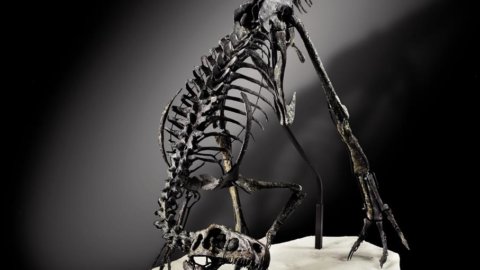The next Natural History sale at Sotheby’s Paris on 30 September 2014 is sure to delight both seasoned collectors and new enthusiasts. Marvels of Nature, rediscovered fossils and skeletons of vanished creatures will retrace the spectacular history of Evolution down the millennia. Although this is a field that remains unfamiliar to many, it is attracting more and more collectors who see a unique opportunity to fulfil childhood dreams amongst long-lost giants elevated to the status of art. Such creatures have fascinated connoisseurs of rarities since the 16th century, with their appeal given fresh impetus at the start of the 20th century by artists of the Avant-Garde.
Sotheby’s were among the first auctioneers to stage sales devoted to Natural History. In 1997 a complete Tyrannosaurus Rex known as Sue, 42 feet long and 12 feet high, with teeth and vertebrae intact, attained a record $8.4m and now welcomes visitors to the Field Museum in Chicago. This Autumn, Sotheby’s Paris will unveil other marvels with a mythical aura – vestiges of an era that crystallize our wildest dreams and transport us back to our most unexpected origins.
Skeletons & Fossilized Specimens
The sale’s exceptional creatures include an Ornitholestes (literally ‘bird robber’) – a small, carnivorous dinosaur around 7ft long, which lived towards the end of the Jurassic Period 150 million years ago. Despite its small size, its long lower limbs gave it tremendous speed and agility, making it a formidable hunter. The ornitholestes ate small mammals, lizards and birds in wooded areas. The holotype, discovered in 1990, enabled scientific knowledge about the ornitholestes to advance, and the specimen to be offered at Sotheby’s was important in adding to this knowledge (est. €350,000-450,000 / $476,900-613,098).
The Woolly Rhinoceros (Coeldonta Antiquitatis) lived in the icy steppes of Eurasia. It was large and robust, 5-7 feet tall, over 10 feet long and weighed 2-3 tons. Its main characteristics were a thick brown coat to protect it against the cold, and its two central horns. Collectors will have the chance to acquire one such horn, 27 in length and especially well preserved (est. €15,000-20,000 / $20,437-27,249).
The sale includes aquatic as well as land-based creatures, including an Ichtyosaur Stenopterygius Quadridcissus fossil from the early Jurassic Period (est. €50,000-70,000 / $68,122-95,370). This marine reptile, close to the dolphin, liked warm, shallow seas, speeding through the water in pursuit of cephalopods and other fish armed with a long beak enclosing a row of jagged teeth. This large fossil, 6ft 3in long, retains its four skeleton legs and stands out majestically against its background of slate.
Mineralized/Fossilized Panels & Other Curiosities
Collectors can admire a magnificent group of three elegant sea-lilies (Seirocrinus Subangularis – Lias) 180 million years old, enlaced for eternity on a natural tableau (8ft 6in x 5ft 3in). The tentacular sea-lily owes its name to its floral appearance, sometimes with Surrealist overtones. These three lilies are fixed to a natural stone panel and unfurl their corollas in a spectacular fashion, magnified by the fine layer of pyrite that covers them, giving them an iridescent sheen (est. €75,000-95,000 / $102,183-129,432).
In an unexpected marriage, Natural History encounters Furniture as they come together to form a large table, topped with a prehistoric petrified wooden panel 220 million years old. The wood comes from giant trees which fell and accumulated in rivers, and were then welded together through the ages by fine mineral particles borne by the water’s current, with the wood’s texture gradually transformed into a mineral substance. The table-top, with a pretty café au lait colour, is mounted on an oak support to form a made-to-measure piece of furniture that is absolutely unique (est. €60,000-80,000 / $81,746-108,995).
Gems & Other Marvels
A rare ammonite 65-135 million years old (Ammonite Placenticeras, Cretaceous/Mezoic SP), mounted on a plinth, will enchant the most demanding of aesthetes. Its surface is covered with ammolite, a matter considered precious (much like opal) and often used for jewellery. It comes exclusively from southern Alberta (Canada), and was venerated by the Blackfoot Indians – who wore it in ceremonies preceding bison hunts. Ammonite stands out from its rivals because of its intense colours and incomparable iridescent gleam (est. €45,000-55,000 / $61,310-74,934).
Tourmaline, rubellite, topaz, agate, rhodolite, emerald, ruby, sapphire, fire opal, turquoise, malachite, jade, aquamarine, rhodocrosite… the sale boasts an important ensemble of 130 gems (full list available on request) totalling over 600 carats (est. €5,000-6,000 / $6,812-8,175). These precious stones, presented in their own showcases, are certain to catch the eye!
Auction: Tuesday 30 September





